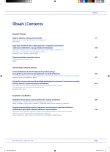Regression of an Osteolytic Lesion in a Patient with Multiple Myeloma Treated with Clodronate after a Successful Therapy with Bortezomib-based Regimen
Authors:
P. Szturz 1; R. Jakubcová 2; Z. Adam 1; M. Klincová 3; M. Krejčí 1; L. Pour 1; L. Zahradová 1; R. Hájek 1; J. Mayer 1
Authors‘ workplace:
Interní hematoonkologická klinika, LF MU a FN Brno
1; Radiologická klinika, LF MU a FN Brno
2; Lékařská fakulta Masarykovy Univerzity, Brno
3
Published in:
Klin Onkol 2011; 24(3): 216-220
Category:
Case Reports
Overview
Backgrounds:
Osteolytic lesions are a common manifestation of multiple myeloma, though their healing is rare in these patients. Generally, during a complete remission, lesions only stop progressing; radiologically evident recalcification is exceptional.
Case:
Herein we report a case of a male patient born in 1941 and diagnosed in 2005 with IgA multiple myeloma presenting with multiple osteolytic bone lesions. Administration of 4 cycles of VAD chemotherapy (vincristine, adriamycin, dexamethasone) with subsequent autologous peripheral blood stem cell transplantation and maintenance treatment with interferon alpha had resulted into a very good partial remission. In 2009, the disease relapsed with enlargement of osteolytic lesions evident on skiagrams. The largest lesion, reaching 24 × 10 mm in size, was located in the left femur. A complete remission of the disease was achieved with CVD senior regimen (cyclophosphamide, bortezomib, dexamethasone, 8 cycles in total). Bisphosphonates (zoledronate, ibandronate and, from 2007, clodronate) were administered as a long-term supportive therapy. A one-year follow-up skiagram of the left femur revealed over 50% regression of the osteolytic lesion (10 × 5 mm) documented in a set of pictures herein.
Conclusion:
A complete remission of the disease after an administration of bortezomib (Velcade™)-based regimen in a long-term clodronate (Bonefos™)-treated patient with relapsed multiple myeloma is radiographically apparent by clear healing signs of the osteolytic bone lesion.
Key words:
multiple myeloma – bortezomib – bisphosphonates – osteolysis – osteogenesis – radiography
This publication was prepared as part of the MUNI/A/1012/2009 project entitled “Optimizing diagnostics and therapy of malignant diseases and complications associated with these malignant diseases using new molecular and biological methods” as well as it is a part of activities within the Ministry of Health of the Czech Republic’s Internal Grant Agency grants: NR9225, NS10387 a NS10406.
The authors declare they have no potential conflicts of interest concerning drugs, products, or services used in the study.
The Editorial Board declares that the manuscript met the ICMJE “uniform requirements” for biomedical papers.
Sources
1. Adam Z, Mayer J, Hájek R et al. Terapie mnohočetného myelomu: zhodnocení přínosu vysokodávkované chemoterapie, interferonu alfa a bisfosfonátů. Klin Onkol 1999; 12(2): 35–44.
2. Roodman GD. Mechanisms of bone lesions in multiple myeloma and lymphoma. Cancer 1997; 80 (Suppl 8): 1557–1563.
3. Adam Z, Ševčík P, Vorlíček J et al. Kostní nádorová choroba. Praha: Grada 2005.
4. Ščudla V, Budíková M, Petrová P et al. Analýza sérových hladin vybraných biologických ukazatelů u monoklonální gamapatie nejistého významu a mnohočetného myelomu. Klin Onkol 2010; 23(3): 171–181.
5. Bačovský J, Ščudla V. Současné možnosti vyšetření skeletu u mnohočetného myelomu. Int Med pro Praxi 2004; 6(8): 385–388.
6. Heider U, Kaiser M, Müller C et ak. Bortezomib increases osteoblast activity in myeloma patients irrespective of response to treatment. Eur J Haematol 2006; 77(3): 233–238.
7. Ozaki S, Tanaka O, Fujii S et al. Therapy with bortezomib plus dexamethasone induces osteoblast activation in responsive patients with multiple myeloma. Int J Hematol 2007; 86(2): 180–185.
8. Lund T, Søe K, Abildgaard N et al. First-line treatment with bortezomib rapidly stimulates both osteoblast activity and bone matrix deposition in patients with multiple myeloma, and stimulates osteoblast proliferation and differentiation in vitro. Eur J Haematol 2010; 85(4): 290–299.
9. Pour L, Hájek R, Adam Z. Výběr bisfosfonátu k léčbě kostního postižení u pacientů s prokázanou malignitou. Klin Onkol 2005; 18(5): 172–177.
10. Ross JR, Saunders Y, Edmonds PM et al. A systematic review of the role of bisphosphonates in metastatic disease. Health Technol Assess 2004; 8(4): 1–176.
11. Wong R, Wiffen PJ. Bisphosphonates for the relief of pain secondary to bone metastases. Cochrane Database Syst Rev 2002; 2: CD002068.
12. Adam Z, Prokeš B, Hájek D et al. Vzestup kostní denzity u nemocných s mnohočetným myelomem léčených clodronátem. Vnitř Lék 1994; 40(11): 726–729.
13. Vokurka S. Bortezomib v léčbě mnohočetného myelomu u pacientů po alogenní transplantaci krvetvorných buněk. Klin Onkol 2010; 23(4): 242–244.
14. Špička I. Bortezomib v 1. linii terapie – další zlepšení výsledků léčby mnohočetného myelomu. Farmakoterapie 2009; 5(2): 113–248.
Labels
Paediatric clinical oncology Surgery Clinical oncologyArticle was published in
Clinical Oncology

2011 Issue 3
- Metamizole vs. Tramadol in Postoperative Analgesia
- Metamizole at a Glance and in Practice – Effective Non-Opioid Analgesic for All Ages
- Metamizole in perioperative treatment in children under 14 years – results of a questionnaire survey from practice
- Possibilities of Using Metamizole in the Treatment of Acute Primary Headaches
- Safety and Tolerance of Metamizole in Postoperative Analgesia in Children
Most read in this issue
- Gastrointestinal Stromal Tumors
- Selenium and Cancer: from Prevention to Treatment
- Can Cancer Patient in Terminal Stage of Cancer Die with Dignity at Home? And under what Conditions?
- Radiotherapy and the Flow of Data and Documentation
